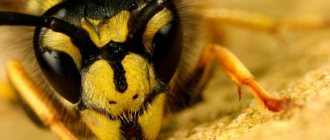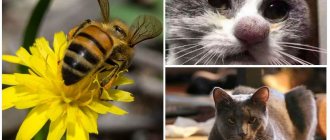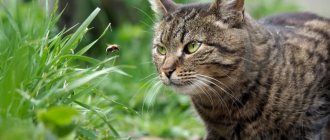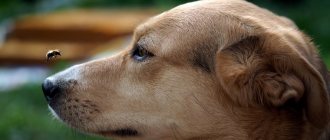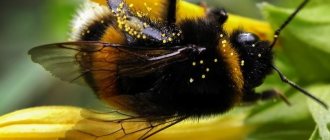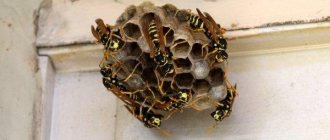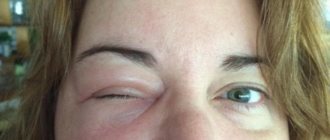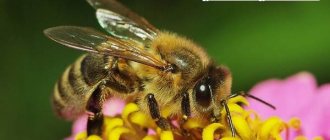A bee is a quite useful insect that produces wax, honey, and propolis. However, despite its benefits, many people are afraid of it. The reason for this is a bee sting.
Bees are not the only insects that bite humans. There are many others that harm humans, such as wasps, bumblebees, house ants, cockroaches and bedbugs. But today we will talk about bees.
To prevent undesirable consequences after a bee sting, you need to have an idea of how dangerous it is, what the body’s reactions may be and how to act in such a situation.
Bite symptoms
- Instant, sharp pain (often with a throbbing burning sensation), concentrated mainly at the site of the bite.
- A protruding black sting in a tiny bag of poison.
- Localized redness appears (no more than 10 cm in diameter), and after half an hour severe itching appears.
- The area of skin or the entire affected area becomes very swollen, with peak swelling occurring within 48-72 hours.
- Swelling of the stung area. For allergy sufferers, symptoms can worsen greatly, as swelling of the mucous membranes, breathing problems, and changes in heart rate may appear.
Providing first aid for a bee sting
- It’s good to examine the site of the bite; it looks like a bright pink papule with a bee sting in the middle. If you do not observe it, then most likely it has gone deeper into the wound; it may also be that you were bitten by a wasp, and it does not leave a sting in the victim.
- The sting should be removed from the skin. If you have slightly overgrown nails, you can remove them, but preferably with tweezers. If the sting remains in the skin, it must be squeezed out; you must squeeze until you see drops of blood, in which case some of the poison will come out.
- You should go over the bite site with a cotton pad that has been previously moistened with an antiseptic. Any remedy will do - chlorhexidine, hydrogen peroxide, iodine or brilliant green.
- Next you need to apply cold. You can use frozen meat from the freezer, but first you need to wrap it in a clean cotton towel.
- It is important to treat the stung area of skin with a local antihistamine, this can be Fenistil in the form of a gel or Psilo-balm.
- You should also be sure to take an antihistamine. This measure of necessary assistance, especially if an overly active reaction of the body occurs (rash, huge swelling, suffocation, etc.), including if the victim is prone to allergies, as well as in children under 12 years of age.
We advise giving a person stung by a bee plenty of fluids - water, sweet tea, compote. This is done in order to reduce the concentration of poison in the human body and speed up its elimination.
Note! If a bee has bitten you in the eye, then you cannot do without an ambulance; you must first complete the entire first aid algorithm.
Further treatment
Most often, after providing first aid, nothing needs to be done. Sometimes it is necessary to smear the affected area with antihistamines. This will help relieve swelling. It is important to consider that 2% of people experience an allergic reaction to bites. They can lead to negative consequences, including death. In such a situation, you need to consult a doctor.
Urgent medical care is needed in the following cases:
- Multiple bites. In such a situation, a high concentration of bee venom can cause negative consequences, including respiratory arrest.
- Bites to the eyes, mouth area, neck. In the first case, there is a risk of developing serious inflammation of the visual organ. In this case, damage to the neck and oral cavity can provoke suffocation due to swelling of the tissues of the respiratory tract.
- Allergic reactions. Dangerous symptoms include shortness of breath, sore or cramping throat, and a feeling of tightness in the chest. There is also a risk of massive swelling, rashes, nausea and vomiting. Some people experience breathing problems and fainting.
See also
What exactly do bees eat in nature and in the apiary? Do insects eat honey? Read
In such situations, you need to call an ambulance or take the victim to a medical facility yourself. A doctor's consultation is also required if severe swelling and redness in the affected area persists for 3 days. In such a situation, the specialist will prescribe medications that will eliminate these symptoms. An antihistamine usually helps in such cases.
What to do if a child is bitten by a bee
With young children (under 10 years old), it is important to be more careful, as a bite can turn into an allergy to bee venom. The harmful effects of a bite are also due to the fact that a child’s body weight is much smaller than an adult’s, so the toxic effect of the poison is more pronounced.
If the bite is located near the mouth, throat or eyes, you should immediately call an ambulance. It is recommended to remove the sting from the baby's skin as soon as possible.
If a child is bitten by a bee on a limb, arm or leg, then the consequences are much simpler, so you can stop the consequences yourself.
What to do if a bee stings your hand?
- First of all, you need to give your child plenty of drink (teas, compotes or juices).
- Remove the sting. And reduce the rate of spread of poison throughout the body by contacting the stung area with cold.
- It is important to explain to the child that it is forbidden to scratch the bitten area. If the baby is still very small, then you will have to make sure that he does not scratch.
- It is necessary to give antihistamines in the dosage recommended by the manufacturer (Tavigil or Suprostin), cream or ointment, for example, Finistil.
How to remove a tumor if bitten by a bee, folk remedies:
- Plantain leaf.
- A piece of onion, garlic.
- Soda with water.
Bee venom: its components and their properties on humans
Bee venom or, as it is also called, apitoxin is produced by worker bees. It is a thick transparent liquid with a slight odor of honey and a bitter taste. Apitoxin has a very complex composition and has a strong active effect. The poison contains not only proteins and amino acids, but also fat-like and mineral substances. It consists of 50% water.
The main dry element of apitoxin is melitin and other toxic polypeptides, which, interacting with organic acids, magnesium and proteins with enzymatic properties (phospholipase A2, hyaluronidase, acid phosphatase) make it therapeutic. Hyaluronidase, for example, promotes the rapid spread of apitoxin, and phospholipase A2 reduces blood clotting. But histamine, which is part of apitoxin, causes swelling of the tissue in the bitten area and is the main cause of anaphylactic shock, but at the same time, thanks to it, apitoxin helps reduce blood pressure and dilates blood vessels.
Bee venom contains the following amino acids:
- alanine;
- isoleucine;
- arginine;
- cystine;
- glycine;
- tryptophan.
Also, minerals such as manganese, sulfur, phosphorus, iodine and others were found in it. The sting causes a strong burning sensation due to the acids (formic, phosphoric, hydrochloric) included in its composition. The effect of poison on a person depends not only on its amount entering the blood, but also on the place of penetration and individual intolerance.
How to help a dog stung by a bee
The first step is to understand where the bee bit the dog, then disinfect the tweezers and remove the sting.
Then perform the following actions:
- Gently wash the bite area with clean distilled water or baby soap. Only in this case it is important to try not to make soap into the wound itself.
- Give the injured pet an antihistamine; it can be bought at a veterinary pharmacy, but some dog breeders say that human antihistamines can also be given.
- The wound from which you removed the insect sting should be poured with hydrogen peroxide, and excess peroxide should be absorbed with paper towels.
- Next, the punk needs to be anointed with anti-itching ointment, for example, Tavegil.
- Then apply a cold compress to the stung area of skin for 20 minutes, with short breaks, so that the cold does not freeze the dog too much.
- If swelling is severe, it is appropriate to give your dog a diuretic (such as Lasix or Ugeril).
- It is advisable to lighten the dog’s diet for 3-4 days and replace the usual diet with lighter foods. This is necessary so that the body fights the poison, and does not waste energy on digesting heavy food.
- It is important to provide your dog with constant access to clean drinking water.
This algorithm of action can also be applied if a bee has bitten a cat.
Important! Try to closely monitor the condition and health of your pet for the first 24 hours after the bite. If alarming symptoms appear: hoarse breathing, cough, rash or severe swelling, then you should immediately take your dog to a veterinary clinic for qualified assistance.
Prevention
To avoid bee stings, you need to follow simple recommendations:
- If a bee flies very close, you should not try to drive it away. It is important to remain calm and not make sudden movements until the insect flies away.
- Experts do not advise being afraid of bees. Many scientists claim that insects sense how adrenaline is produced.
- Don't wear bright clothes that attract bees.
- It is not recommended to use perfumes and deodorants that have strong odors. They attract insects.
- You should not walk barefoot on the grass.
Bee stings can pose a real danger to human health and life. Therefore, it is important to provide first aid to the victim in a timely manner. If allergy symptoms appear, a person must be immediately taken to a medical facility.
Consequences of a bee sting
For many people, the swelling and swelling subsides within 2-.5 hours - the most important thing here is not to scratch the damaged area. But for about 1 percent of people, bee stings cause dangerous consequences.
Anaphylaxis is a dangerous allergic reaction that threatens the life of the victim. Its symptoms are as follows:
- The neck and larynx swell terribly;
- Breathing becomes difficult - it noticeably quickens, it is difficult to breathe, sometimes even wheezing appears;
- Blood pressure drops rapidly, and the pulse becomes threadlike;
- Dizziness, signs of nausea may appear;
- The victim loses consciousness.
If anaphylactic juice appears, then you need to immediately call an ambulance, since it will not be possible to cope without experienced doctors.
Classification
Bee stings can be single or multiple. In the first case, sharp and burning pain occurs in the affected area. You can also see that the area is swollen and red. Multiple bites are considered more dangerous. They pose a real threat even to people who do not have allergies.
Also, stings are classified depending on the type of bee. Thus, people are bitten by both domestic and wild insects. It is worth noting that in the second case the risk of developing allergies is significantly higher.
How to Avoid a Bee Sting
To avoid becoming a victim of a bee, you should follow some rules:
- Eat sweets and fruits carefully and attentively, especially in nature.
- If you are going on vacation in the fresh air, choose neutral colors of clothing.
- A hat and clothing covering arms and legs protects against suspected bites.
- You should not smell of perfume, deodorant, cigarettes, alcohol or gasoline, as these odors greatly anger the bees.
- You should be especially careful when walking in open shoes when meadows and herbs are in bloom.
- The bees' anger only intensifies with sharp swings of their hands, so if the bee had no intention of stinging you before, then your swings may change its mind. This recommendation applies to all flying and biting insects.
- There is no need to disturb the hive and approach them less than 3 meters.
- You need to treat yourself with products that will repel insects.
- When caring for an apiary, it is important to use protective equipment.
We hope you found this article helpful. Remember that if a severe allergic reaction is observed after a bite, you should immediately call an ambulance. All the best!
A bit of Wikipedia
Honey bee (Apidae)
A bee (lat. Anthophila) is a flying insect from the order Hymenoptera. At the moment, more than 21 thousand species of bees have been identified and described. They are found everywhere except Antarctica, which is logical. Bees feed on nectar and pollen. They have the property of eusociality - a certain form of organization of communities of animals and insects, in which some individuals do not participate in the reproduction process, but are busy obtaining food and protecting the group.
In our latitudes, honey bees, members of the family “True bees” (Apidae), predominate. Bees play a vital role for the ecosystem and humans in particular, pollinating various plants. “If bees suddenly disappear, then after four years man will disappear too” - these are not my words, Einstein said them (but there is another, more boring, version of the origin of this phrase).
